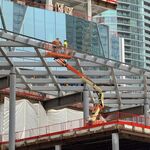Parc Ex is a working class South Asian immigrant neighbourhood, so it's possible that there's a lot more extended families and multiple-people-to-a-room situations that make the area denser than it may appear from the outside.
A similar area, demographically, would be the stretch of Jamieson in Parkdale.
Sort of OT to Toronto, but the V6B/Yaletown forward sortation area in Vancouver is surprising, since it has only been developed in the past 20 years, and is mostly middle and upper-middle class singles and couples with a few families with very young children. Also, the northern third is very commercial and isn't known to be a residential area, so it makes the density of that area even more impressive. It's dense in a visual sense, but, based on its demographics and the surprising amount of open space in the area, I was surprised it ranked up there.
Parc Extension is not that surprising to me. It has a lot of 3-4 storey apartment buildings with no side setbacks and small yards. I think the densest city blocks have densities around 30-40,000 p/km2, which is brought down by 2 storey plexes, schools, parks, and a few bungalow city blocks. Similar built forms are pretty rare outside Montreal. Mostly you either have row houses, sometimes subdivided into apartments, but often just 2 storey and with more yard space, or you have low rise (and taller) apartment complexes with more residual greenspace ("in the park"). The closest I can think of might be some of the stacked/back to back townhouse complexes, and these can be quite dense.
There one on Everson Drive in North York that supposedly has 64,000p/km2. I initially thought Statscan made a mistake when they reported just how many people were living in that block. According to Statscan, this stacked back to back townhouse complex has a little over 700 units. They have 4 floors of living space, and based on satellite images, it looks like there's around 45% ground coverage, so you'd need about 300sf per person. That's tight, so I'm not sure I'm willing to believe it, but even with 450sf per person, you'd have high densities around 42,000 p/km2.
The Westernmost blocks of Parc-Ex between de l'Epee and Wiseman have a density of 33,000/km2. It has 2-4 storey apartments largely attached side by side. Parc-Ex had about 10% of households with more people than rooms, so it is more crowded than the average Canadian neighbourhood, but still not nearly as bad as parts of Thorncliffe Park. The census tract that contains the five towers SE of Thorncliffe Park Drive had about 30% of households with more people than rooms in 2006, and has gained 13.7% in population from 2006 to 2011 with no new construction. Meanwhile, Parc-Ex lost population from 2006 to 2011.
The densest wards of Montreal in 1931 were around Parc Lafontaine, and had densities of 30,000-40,000 p/km2 in what were mostly 2-3 storey plexes.
I'd say that 25-30,000/km2 per residential FSI would be typical (for 500sf/person including space like hallways, stairwells and walls). So you'd have to include space for schools, commercial, parks and streets, possibly industry too for neighbourhood level calculations. About 30-35% of land for streets is typical. Retail/office is not too much. Schools/parks can be maybe 10-30% of land area. Other institutional land uses and industry can vary quite a lot. The "walled city of Lower Sherbourne" proposal had an FSI of around 12.5 across a whole city block. That drops to about 8.85 going up the midpoint of surrounding streets. Adding parks, schools, etc, the density might end up around 150,000 p/km2 for a neighbourhood built up in that manner.




